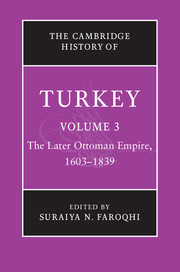Book contents
- Frontmatter
- PART I BACKGROUND
- PART II AN EMPIRE IN TRANSITION
- PART III THE CENTRE AND THE PROVINCES
- PART IV SOCIAL, RELIGIOUS AND POLITICAL GROUPS
- PART V MAKING A LIVING
- 14 Capitulations and Western trade
- 15 Guildsmen and handicraft producers
- 16 Declines and revivals in textile production
- 17 Rural life
- PART VI CULTURE AND THE ARTS
- Glossary
- Bibliography
- Index
- References
16 - Declines and revivals in textile production
from PART V - MAKING A LIVING
Published online by Cambridge University Press: 28 March 2008
- Frontmatter
- PART I BACKGROUND
- PART II AN EMPIRE IN TRANSITION
- PART III THE CENTRE AND THE PROVINCES
- PART IV SOCIAL, RELIGIOUS AND POLITICAL GROUPS
- PART V MAKING A LIVING
- 14 Capitulations and Western trade
- 15 Guildsmen and handicraft producers
- 16 Declines and revivals in textile production
- 17 Rural life
- PART VI CULTURE AND THE ARTS
- Glossary
- Bibliography
- Index
- References
Summary
Textiles as indicators
In the Ottoman Empire as in most pre-industrial societies, the manufacture of textiles constituted one of the most significant, and also best documented, of industrial activities. In consequence, by discussing silk, wool and cotton manufactures we may shed some light on Ottoman craft activity as a whole. Internal trade in manufactured goods was largely a trade in textiles and, to some extent, Ottoman fabrics were also exported. Thus textile production furnished occasions for economic integration in a way that was true of few other crafts. However, a caveat is in order: in the 1960s and 1970s, historians writing the history of a single textile tended to assume that the growth and decline of the relevant industry mirrored Ottoman craft activity as a whole. A comparison of the trajectories of different handicrafts in medieval and early modern Europe has, however, shown that such industries typically follow a parabola curve: an impressive expansion is usually followed by an equally rapid decline. Industrial collapse may be caused by the competition of rival production centres, but also by wars, excessive taxation and other non-economic factors, which may originate both within and without the state at issue.
- Type
- Chapter
- Information
- The Cambridge History of Turkey , pp. 356 - 375Publisher: Cambridge University PressPrint publication year: 2006
References
- 3
- Cited by



